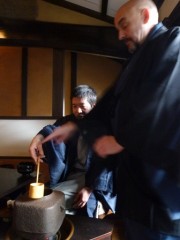13 February 2013
Learning Japanese heritage from a Canadian
I went to Kyoto last weekend holidays. The main purpose of the trip was to meet a foreign instructor of Japanese Sado. Do you know what Sado is? Sa means tea, Do means way, meaning "Way of tea." You can learn how to serve tea and sweets to guests and how to be served as guests.
Some people not only foreiners but even Japanese claim that it is too much of formality. I always thought that way. But my encounter with this Sado instructor changed my view.
His name is Randy-san. He manages a cafe in Kyoto. He is a Canadian man who has lived in Japan for more than 20 years. He first came to Japan to learn martial arts but later found out he had to be skillful for both martial arts and academic things. Then he chose Sado.
I joined his cafe's tea ceremony lesson for beginners. 6 students including me attended the lesson. His Japanese is excellent. He wore a very suitable kimono for tea ceremony. Only I wore kimono among 6 Japanese attendees. Actually my kimono was not suitable for tea ceremony.
He could explain every detail of Sado such as how to prepare and proceed.
Then each student was instructed to perfom how to do each act of pouring hot water, mix with tea powder and then serve guests and how to be served. It is precisely ruled like social dances. No free form on your own. You have to memorize each act and perform that in public to be a good host and guest. That is kind of a hard thing to do. Interesting those things should be taught by a Japanese instructor but this time the other way around. I, Japanese was a student and Randy-san, Canadian was an instructor.

He said "up, pull, cover" when I try to bring up hot water from the pot. I had to repeat that 3 times. Weird, just for bringing up, you have to know how to do each act. But that is the way of tea ceremony.
I asked him why we should follow so many rules just for tea ceremony.
He answered that we should not consider them rules rather these are manners. It is fun to have meals and drinks without manners in casual clothes relaxing at home. But you can also enjoy formal dinner at high class restaurant wearing formal clothes. Just like that. You can enjoy such formality.
He said significance of Sado is like significance of life.
Wow, it seems a foreinger, westerner had a better view on Japanese culture because he sees things objectively.
Maybe that is a dilenma we, Japanese including me have had for a long time. He just seemed to solve that instantly.
It is like how I learnt why Geisha girls put thick white make-ups on their faces by a Hollywood film "Memoirs of a Geisha." In the old days party rooms were so dark without strong lights that Geishas needed such make-ups to shine their faces to be recognized. Japanese films don't usually show indoor darkness of the old days. Without knowing darkness of that period, you can never learn how the old time people live and see the world. Hollywood did a better job in that sense.
Ironically Randy-san got me more interest in one of my country's heritage. Similar thing happened in sports field recently. Judo has been criticized for causing scandals such as harrassment and violent instruction to female athletes. International Judo organization denouced that scandal saying that violent instruction is against original philosophy established by a founder of Judo, Kano Jigoro.
We, Japanese are forgetting what we really are. We have to bring it back!
14:21 Posted in Canada, Culture, Japan News, Sports, Travel | Permalink | Comments (0) | Tags: kyoto, kimono, tea ceremony





